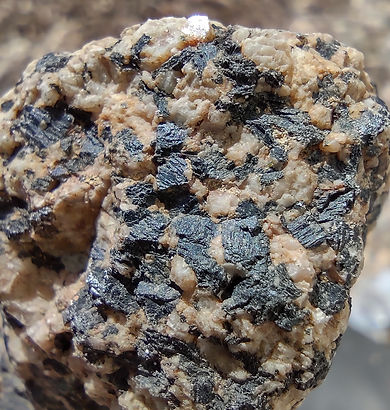

Become A Member For Free Here
Single Minerals
These are minerals Mr. Alexander has only one example of that don't need a dedicated page.


Cerussite is a lead carbonate. It is an important ore and common secondary mineral of lead.
Colors It Comes In - Colorless, White, Gray, pale Yellow, Blue, or Green
Fracture - Conchoidal
Shape - Prismatic or Tabular habit, with elongated or flattened crystals
Luster - Adamantine, Vitreous, Resinous, Submetallic, Pearly
Texture - Glass like to waxy
Streak - White
Locality - Germany, the Czech Republic, Slovenia, Scotland, England, France, Italy, Russia, Tunisia, Morocco, Namibia, Iran, Australia, and the United States.
Where It Can Be Found - In oxidized lead deposits where it can, on occasion, be an important ore.
Hardness On The Mohs Scale - 3 To 3.5 Out Of 10
Cerussite


Pumice is formed when lava and water mix together. Pumice is a volcanic rock that consists of highly vesicular rough-textured volcanic glass, which may or may not contain crystals.
Colors It Comes In - White, Yellowish, light to dark Gray, Blue, Green-Brown, or Black, depending on the type of lava from which it forms. Pumices from silica-rich lavas are White, those from lavas with intermediate silica content are often Yellow or Brown, and rarer silica-poor that are Black.
Luster - Earthy
Texture - Vesicular
Streak - White, Greenish White or Grey
Locality - Spain
Where It Can Be Found - Afghanistan, Indonesia, Japan, Russia, Ethiopia, Kenya, Tanzania, Greece, Hungary, Iceland, Italy, Turkey, Bahamas, Barbados, Canada, Costa Rica, Cuba, Jamaica, Mexico, USA, Argentina, Chile, Ecuador, Peru, New Zealand, Western Australia
Hardness On The Mohs Scale - 6 Out Of 10
Pumice
Purpurite

Purpurite is a manganese phosphate mineral with varying amounts of iron depending upon its source.
Colors It Comes In - brownish black, purple, and violet to dark red
Fracture Pattern - Uneven/Irregular
Luster - Earthy, Shiny
Texture - Granular, Chalky
Streak - Purple
Locality - Namibia, South Africa
Where It Can Be Found - North Carolina, South Dakota, California, France, Rwanda, Australia, Portugal, Maine
Hardness On The Mohs Scale - 4 To 4.5 Out Of 10
Hornblende

Hornblende is a complex inosilicate series of minerals. The name is used as a general or field term to refer to dark amphibole. Hornblende minerals are common in igneous and metamorphic rocks.
Colors It Comes In - Black to dark Green or Brown
Fracture - Subconchoidal and Uneven
Shape - Hexagonal, Granular
Luster - Vitreous to Dull
Texture - Irregular grains or fibrous masses
Streak - Pale Gray, Gray-White
Locality - United States, Canada, Norway, and Italy
Where It Can Be Found - It is found in many intrusive igneous rocks ranging in composition from granites to diorite to gabbros to syenites. It occurs as phenocrysts in several varieties of extrusive igneous rocks, such an andesite.
Hardness On The Mohs Scale - 5 To 6 Out Of 10
Manganese Dendrite Crystal

Dendrites are a type of mineral. They form when manganese or iron oxides crystallize in branching patterns on the surface of or inside of rocks. These patterns can mimic the appearance of plants or trees, leading to the common misconception that they are fossils.
Colors It Comes In - White, Gray, or Black
Shape - Tree like
Luster - Vitreous, Dull, Waxy
Streak - Brownish-black
Locality - The World
Where It Can Be Found - In Agates and Limestone
Hardness On The Mohs Scale - Dependent on the host rock but manganese oxides are on the softer side.